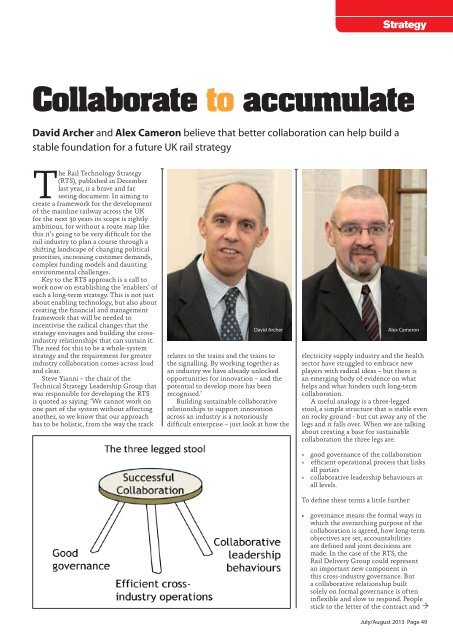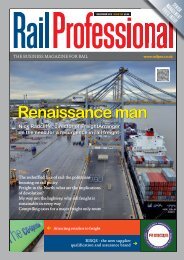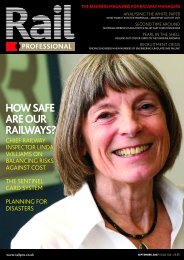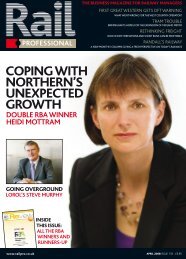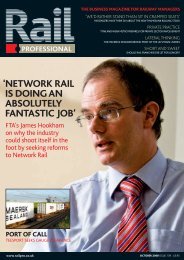View as PDF - Rail Professional
View as PDF - Rail Professional
View as PDF - Rail Professional
You also want an ePaper? Increase the reach of your titles
YUMPU automatically turns print PDFs into web optimized ePapers that Google loves.
Strategy<br />
David Archer and Alex Cameron believe that better collaboration can help build a<br />
stable foundation for a future UK rail strategy<br />
The <strong>Rail</strong> Technology Strategy<br />
(RTS), published in December<br />
l<strong>as</strong>t year, is a brave and far<br />
seeing document. In aiming to<br />
create a framework for the development<br />
of the mainline railway across the UK<br />
for the next 30 years its scope is rightly<br />
ambitious, for without a route map like<br />
this it’s going to be very difficult for the<br />
rail industry to plan a course through a<br />
shifting landscape of changing political<br />
priorities, incre<strong>as</strong>ing customer demands,<br />
complex funding models and daunting<br />
environmental challenges.<br />
Key to the RTS approach is a call to<br />
work now on establishing the ‘enablers’ of<br />
such a long-term strategy. This is not just<br />
about enabling technology, but also about<br />
creating the financial and management<br />
framework that will be needed to<br />
incentivise the radical changes that the<br />
strategy envisages and building the crossindustry<br />
relationships that can sustain it.<br />
The need for this to be a whole-system<br />
strategy and the requirement for greater<br />
industry collaboration comes across loud<br />
and clear.<br />
Steve Yianni – the chair of the<br />
Technical Strategy Leadership Group that<br />
w<strong>as</strong> responsible for developing the RTS<br />
is quoted <strong>as</strong> saying: ‘We cannot work on<br />
one part of the system without affecting<br />
another, so we know that our approach<br />
h<strong>as</strong> to be holistic, from the way the track<br />
relates to the trains and the trains to<br />
the signalling. By working together <strong>as</strong><br />
an industry we have already unlocked<br />
opportunities for innovation – and the<br />
potential to develop more h<strong>as</strong> been<br />
recognised.’<br />
Building sustainable collaborative<br />
relationships to support innovation<br />
across an industry is a notoriously<br />
difficult enterprise – just look at how the<br />
electricity supply industry and the health<br />
sector have struggled to embrace new<br />
players with radical ide<strong>as</strong> – but there is<br />
an emerging body of evidence on what<br />
helps and what hinders such long-term<br />
collaboration.<br />
A useful analogy is a three-legged<br />
stool, a simple structure that is stable even<br />
on rocky ground - but cut away any of the<br />
legs and it falls over. When we are talking<br />
about creating a b<strong>as</strong>e for sustainable<br />
collaboration the three legs are:<br />
*<br />
*<br />
*<br />
good governance of the collaboration<br />
efficient operational process that links<br />
all parties<br />
collaborative leadership behaviours at<br />
all levels.<br />
To define these terms a little further:<br />
• governance means the formal ways in<br />
which the overarching purpose of the<br />
collaboration is agreed, how long-term<br />
objectives are set, accountabilities<br />
are defined and joint decisions are<br />
made. In the c<strong>as</strong>e of the RTS, the<br />
<strong>Rail</strong> Delivery Group could represent<br />
an important new component in<br />
this cross-industry governance. But<br />
a collaborative relationship built<br />
solely on formal governance is often<br />
inflexible and slow to respond. People<br />
stick to the letter of the contract and<br />
July/August 2013 Page 49


